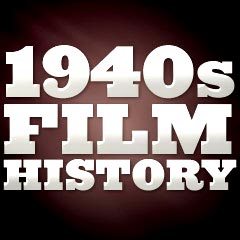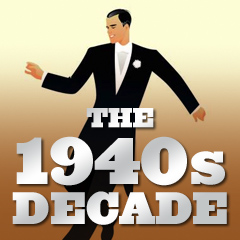|
The Birth of Film Noir:
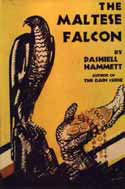 By
World War II's end, the genre most characteristic of the era and most
associated with 1940s Hollywood was film noir.
The film noir 'genre' reflected the way Hollywood felt as it faced
its greatest challenges during the war and post-war periods - darker and
more cynical. The somber, pessimistic 'genre', literally meaning "black
film," was already germinating and evolving from 30s gangster films -
with dark plots, untrustworthy femme fatales, and tough, but cynical,
fatalistic heroes. By
World War II's end, the genre most characteristic of the era and most
associated with 1940s Hollywood was film noir.
The film noir 'genre' reflected the way Hollywood felt as it faced
its greatest challenges during the war and post-war periods - darker and
more cynical. The somber, pessimistic 'genre', literally meaning "black
film," was already germinating and evolving from 30s gangster films -
with dark plots, untrustworthy femme fatales, and tough, but cynical,
fatalistic heroes.
The first, clearly definitive example was one of the best
hard-boiled detective pictures ever made - director John Huston's remarkable
debut film The Maltese Falcon (1941). [This
was the third version of the film mystery.] The film about a treasure
search for a black bird, adapted from Dashiell Hammett's novel, marked
a turning point for actor Humphrey Bogart - it made him a star as private
eye gumshoe Sam Spade. The chiaroscuro lighting of Welles' Citizen
Kane (1941) by cinematographer Gregg Toland, and the Neo-realism
of European film-makers also had an influence on the burgeoning stylistic
art form. Film noir became prominent in the post-war
era, and lasted in a classic "Golden Age" period until about
1960 - marked by Orson Welles' Touch of Evil (1958).
The Most Notable Film Noirs in the 'Classic' Period
of the 40s:
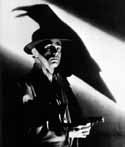 There
were many excellent film noirs in the 40s, including the following: There
were many excellent film noirs in the 40s, including the following:
- Frank Tuttle's This Gun For Hire (1942), a dark
revenge film that made Alan Ladd a star and spotlighted his 'peek-a-boo'
blonde co-star Veronica Lake
- Billy Wilder's classic thriller/film noir Double
Indemnity (1944), from crime novelist Raymond Chandler's adaptation
of James M. Cain's novella about insurance fraud, corruption and adulterous
murder, with Barbara Stanwyck as a deadly blonde, Fred MacMurray as
the agent, and Edward G. Robinson as a dogged insurance investigator
- Laura (1944) with its
haunting theme song and alluring Gene Tierney
- Edward Dmytryk's Murder,
My Sweet (1944), with musical song/dance actor Dick Powell
playing against type as world-weary private detective Philip
Marlowe
- Edgar G. Ulmer's "Poverty Row" Detour (1945)
- director Michael Curtiz' Mildred
Pierce (1945) - this 'women's' noir gave Joan Crawford her first (and only)
career Oscar as Best Actress for her role as a self-sacrificing mother,
and a revitalized career
- Gilda (1946) with Rita
Hayworth's notorious black-glove strip-tease "Put the Blame on Mame"
- Howard Hawks' plot-convoluted and impenetrable The
Big Sleep (1946) with Humphrey Bogart as the hard-boiled
detective hero Philip Marlowe (in his second film with off-screen young
wife Lauren Bacall) in an adaptation of Raymond Chandler's first novel
involving blackmail, murder, and more
- director/star Robert Montgomery's Lady in the Lake
(1946) - another tale about detective Philip Marlowe in a story
adapted for the screen by Raymond Chandler
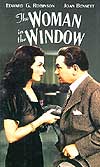 Tay Garnett's The Postman Always Rings Twice
(1946) was an adaptation of James M. Cain's novel about a plot
to murder the cafe-owner husband of Lana Turner by her lover John Garfield
Tay Garnett's The Postman Always Rings Twice
(1946) was an adaptation of James M. Cain's novel about a plot
to murder the cafe-owner husband of Lana Turner by her lover John Garfield- Fritz Lang's Woman in the Window (1944) and
Scarlet Street (1946)
- Robert Siodmak's The Killers
(1946) (with the screen debut of actor Burt Lancaster and a
star-making role for actress Ava Gardner) and Cry of the City (1948)
- Robert Rossen's boxing noir Body and Soul (1947) with John Garfield as a champion boxer forced to decide whether to throw a big fight
- Edward Dmytryk's noirish political drama Crossfire (1947) told about the social issue of anti-semitism prejudice, in its flashback story regarding an investigation (by Robert Mitchum and Robert Young) into the mysterious murder of a Jew by a bigoted GI soldier (Robert Ryan)
- Delmer Daves' Dark Passage (1947), with Bogart
as the main character (again paired opposite Lauren Bacall) who has
undergone plastic surgery - the film was noted for its 'subjective camera'
(viewing through the 'eyes' of the bandaged patient) for the first half
of the film
- Henry Hathaway's crime-noir Kiss of Death (1947)
- with the screen debut of Oscar-nominated Richard Widmark as a homicidal
psychopath
- Jacques Tourneur's intricate double-cross murder/romance
- the penultimate noir thriller Out of the Past
(1947) with femme fatale Jane Greer
- Abraham Polonsky's Force of Evil (1948) with
John Garfield
- the classic boxing drama, Champion (1949) -
a star-making film for Kirk Douglas
- Raoul Walsh's film noirish gangster film White
Heat (1949) with James Cagney as a mother-fixated, sadistic
killer who blew himself up on an oil tank in the fiery climax, screaming:
"Made it, Ma! Top of the world!"
- Robert Wise's The Set-Up (1949), with Robert
Ryan as an aging boxer, dealt with corruption in the sport of boxing
- Nicholas Ray's They Live By Night (1949)
Gangster Films Revival:
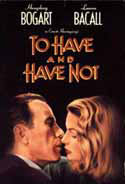 The
gangster movie was revitalized with one of Warner Bros. finest examples
of the genre - director Raoul Walsh's High Sierra (1941), starring
Humphrey Bogart (in his first starring role) as an aging gangster with
a heart of gold. [The "on-screen" "off-screen" romance between Lauren
Bacall and Humphrey Bogart, during the filming of director Howard Hawks'
To Have and Have Not (1944), Bacall's first
film, culminated in their marriage in 1945. The romantic war-time drama
was adapted from Ernest Hemingway's short story, and noted for Bacall's
sizzling come-on: "You know how to whistle, don't you?...Just put
your lips together and blow."] The
gangster movie was revitalized with one of Warner Bros. finest examples
of the genre - director Raoul Walsh's High Sierra (1941), starring
Humphrey Bogart (in his first starring role) as an aging gangster with
a heart of gold. [The "on-screen" "off-screen" romance between Lauren
Bacall and Humphrey Bogart, during the filming of director Howard Hawks'
To Have and Have Not (1944), Bacall's first
film, culminated in their marriage in 1945. The romantic war-time drama
was adapted from Ernest Hemingway's short story, and noted for Bacall's
sizzling come-on: "You know how to whistle, don't you?...Just put
your lips together and blow."]
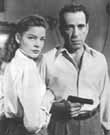 Later
in the decade, the gangster was not romanticized, but portrayed as a bullying
psychopath (i.e., Edward G. Robinson in John Huston's Key Largo (1948),
and James Cagney in White Heat (1949)).
John Huston's mastery of film directorship as one of the most skilled
adapters of classic material was revealed in more Humphrey Bogart collaborations
in the decade. In a film starring his own father Walter, director Huston
revealed the treacherous effects of greed for three prospectors (including
Bogart as Fred C. Dobbs) in The Treasure of the
Sierra Madre (1948) - famous for the oft-quoted (and usually misquoted)
line: "Badges? We ain't got no badges! We don't need no badges. I don't have to show you any stinkin' badges!" Later
in the decade, the gangster was not romanticized, but portrayed as a bullying
psychopath (i.e., Edward G. Robinson in John Huston's Key Largo (1948),
and James Cagney in White Heat (1949)).
John Huston's mastery of film directorship as one of the most skilled
adapters of classic material was revealed in more Humphrey Bogart collaborations
in the decade. In a film starring his own father Walter, director Huston
revealed the treacherous effects of greed for three prospectors (including
Bogart as Fred C. Dobbs) in The Treasure of the
Sierra Madre (1948) - famous for the oft-quoted (and usually misquoted)
line: "Badges? We ain't got no badges! We don't need no badges. I don't have to show you any stinkin' badges!"
The "Road" Comedies:
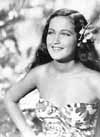 The
famous Paramount Studios' "Road" films (a total of seven films stretching
out until 1962), starred a wise-cracking Bob Hope and his comedy partner
Bing Crosby as two hapless musicians, and their colorful heroine Dorothy
Lamour. The series began at the start of the decade: The
famous Paramount Studios' "Road" films (a total of seven films stretching
out until 1962), starred a wise-cracking Bob Hope and his comedy partner
Bing Crosby as two hapless musicians, and their colorful heroine Dorothy
Lamour. The series began at the start of the decade:
- Road to Singapore (1940)
- Road to Zanzibar (1941)
- Road to Morocco (1942) - the best of the
series
- Road to Utopia (1946)
- Road to Rio (1947)
- Road to Bali (1952)
- The Road to Hong Kong (1962)
Comedy Films: Comedy Teams and Pairs
Ski-nosed Bob Hope also starred in some of his best comedies
during the decade, including My Favorite Blonde (1942) with Madeleine
Carroll, the spy spoof They Got Me Covered (1943), The Princess
and the Pirate (1944) with Virginia Mayo, The Paleface (1949)
(Hope's first color film) with Jane Russell as Calamity Jane, and its
sequel The Son of Paleface (1952).
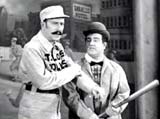 In 1941, comedians Abbott and
Costello made their film debut in Buck Privates (1941), a comedy
about their enlistment into World War II, and the pair would go on to
make many more hit films for Universal Studios, following the decline
of Deanna Durbin's popularity. Abbott and Costello's most famous classic
routine "Who's On First?" was performed in their film The Naughty Nineties (1945). They also
starred in the comedy horror film Abbott & Costello Meet Frankenstein
(1948), scared by the Monster (Glenn Strange), Dracula (Bela Lugosi),
and the Wolf Man (Lon Chaney, Jr.). The comedic team of Dean Martin and
Jerry Lewis made their film debut, the first of their sixteen films
together, in My Friend Irma (1949). In 1941, comedians Abbott and
Costello made their film debut in Buck Privates (1941), a comedy
about their enlistment into World War II, and the pair would go on to
make many more hit films for Universal Studios, following the decline
of Deanna Durbin's popularity. Abbott and Costello's most famous classic
routine "Who's On First?" was performed in their film The Naughty Nineties (1945). They also
starred in the comedy horror film Abbott & Costello Meet Frankenstein
(1948), scared by the Monster (Glenn Strange), Dracula (Bela Lugosi),
and the Wolf Man (Lon Chaney, Jr.). The comedic team of Dean Martin and
Jerry Lewis made their film debut, the first of their sixteen films
together, in My Friend Irma (1949).
The famed comedy team, the Marx Brothers were to retire
from the movies as a screen team in 1941 with their last film, MGM's The
Big Store (1941). However, they later signed with United Artists to
make the independent feature A Night in Casablanca (1946), and
they also appeared in a 'comeback' film, their final film as a
team - Love Happy (1949) with a little-known Marilyn Monroe. And
bawdy screen siren Mae West made her last film (for over 25 years) with
the satirical musical The Heat's On (1943). Laurel and Hardy's
last Hollywood film was The Bullfighters (1945), capping a career
stretching back to their first film, Slipping Wives (1926). Film
comedy lost one of its classic masters with the death of W.C. Fields in
1946. His last scripted film and starring role in a feature-length film
was in Never Give a Sucker an Even Break (1941),
and he made his final film cameo appearance in the musical comedy Sensations
of 1945 (1944) - also the final starring film role for dancer Eleanor
Powell.
The romantic comedy Here Comes Mr. Jordan (1941)
starred Claude Rains in the title role and Robert Montgomery as Joe Pendleton,
a sax-playing prize fighter who was supposed to survive a plane crash,
but was prematurely sent to Heaven - and needed to find a new body on
Earth. Similarly, Ernst Lubitsch's Heaven Can Wait (1943) was the
story of a 70 year-old playboy (Don Ameche) who would have to tell his
life story to the devil, including his unfaithfulness to his forgiving
wife (Gene Tierney).
Cary Grant played the 'son of a sea cook' with lethal
Brewster family aunts Abby and Martha in Frank Capra's macabre comedy
Arsenic and Old Lace (1944). One of Cary
Grant's most under-rated film was Mr. Lucky (1943), as a gambling
casino boat owner, who redeems himself by his love for a virtuous young
woman (Laraine Day). He was also miscast as a playboy sentenced by judge
Myrna Loy to date her sister - an infatuated teenaged Shirley Temple in
the romantic comedy The Bachelor and the Bobby-Soxer (1947). In
the next year, he played the role of a New York adman who moves to the
Connecticut countryside to do some disastrous home improvement in Mr.
Blandings Builds His Dream House (1948).
Cary Grant and Rosalind Russell co-starred and battled
together in Howard Hawks' fast-talking romantic comedy His
Girl Friday (1940) - one of the all-time great screwball comedies.
[This was a wild and innovative retooling of director Lewis Milestone's
The Front Page (1931).]
Hepburn and Tracy:
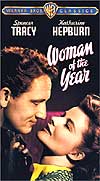 The
first of nine films teaming Katharine Hepburn and Spencer Tracy
together was George Stevens' Woman of the Year (1942). Other comedic
pairings of the watchable duo in the decade included State of the Union
(1948) and their sixth collaboration together - in George Cukor's
marvelous Adam's Rib (1949). The
first of nine films teaming Katharine Hepburn and Spencer Tracy
together was George Stevens' Woman of the Year (1942). Other comedic
pairings of the watchable duo in the decade included State of the Union
(1948) and their sixth collaboration together - in George Cukor's
marvelous Adam's Rib (1949).
Katharine Hepburn also played the role of socialite Tracy
Lord opposite hand-picked Cary Grant as estranged husband C. K. Dexter
Haven in the romantic comedy The Philadelphia Story
(1940) - her comeback film (from being seen as 'box-office poison')
that she had originally performed on the Broadway stage.
Escapist, Nostalgic Entertainment:
Other films either provided escapist entertainment or
nostalgically seemed to look back to a lost era in America, such as the
biographical story of the song-and-dance team of the Cohans, featuring
Best Actor-winning James Cagney as legendary vaudevillian George M. Cohan
in Yankee Doodle Dandy (1942). The musical
comedy Holiday Inn (1942) featured Bing Crosby's first crooning
of White Christmas, and Fred Astaire's and Bing Crosby's first
screen appearance together. Director Vincente Minnelli's third film Meet
Me in St. Louis (1944) was the first of three films he made to
showcase Judy Garland. Bing Crosby reprised his
earlier, Best Actor-winning Catholic priest role as Father Chuck O'Malley
of Going My Way (1944) in the sequel The Bells of St. Mary's
(1945), with Ingrid Bergman as Sister Benedict.
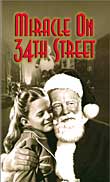 June
Allyson (as Jo), Janet Leigh (as Meg) and Elizabeth Taylor (as Amy) played
sisters in the remake adaptation of Louisa May Alcott's novel Little
Women (1949), set in New England in the 1860s. Two films from MGM
in 1940 portrayed the early youth and inventive genius of Thomas Edison:
Young Tom Edison (1940) (with Mickey Rooney), and Edison, the
Man (1940) (with Spencer Tracy). Fredric March portrayed the author
of Tom Sawyer, Samuel Clemens, in The Adventures of Mark Twain
(1944). Stars abounded in Boom Town (1940), an adventure story
of wildcat drillers with Clark Gable, Spencer Tracy, Claudette Colbert,
and Hedy Lamarr. Child stars Elizabeth Taylor and Mickey Rooney were also
paired in the popular family classic film Lassie Come Home (1943).
The Christmas favorite, Miracle on 34th Street (1947) starred a
young Natalie Wood as skeptical Susan Walker, and Edmund Gwenn as the
Santa character in a Macy's department store in NYC. June
Allyson (as Jo), Janet Leigh (as Meg) and Elizabeth Taylor (as Amy) played
sisters in the remake adaptation of Louisa May Alcott's novel Little
Women (1949), set in New England in the 1860s. Two films from MGM
in 1940 portrayed the early youth and inventive genius of Thomas Edison:
Young Tom Edison (1940) (with Mickey Rooney), and Edison, the
Man (1940) (with Spencer Tracy). Fredric March portrayed the author
of Tom Sawyer, Samuel Clemens, in The Adventures of Mark Twain
(1944). Stars abounded in Boom Town (1940), an adventure story
of wildcat drillers with Clark Gable, Spencer Tracy, Claudette Colbert,
and Hedy Lamarr. Child stars Elizabeth Taylor and Mickey Rooney were also
paired in the popular family classic film Lassie Come Home (1943).
The Christmas favorite, Miracle on 34th Street (1947) starred a
young Natalie Wood as skeptical Susan Walker, and Edmund Gwenn as the
Santa character in a Macy's department store in NYC.
British actor Charles Laughton starred as a haunting,
restless ghost walled up in a castle in MGM's comedy The Canterville
Ghost (1944), from an Oscar Wilde fantasy story. Life
with Father (1947) followed the exploits of the Day family (headed
by strict William Powell) in a turn-of-the-century household, and George
Stevens directed the feel-good drama I Remember
Mama (1948). Audiences thrilled to see Mighty Joe Young (1949)
- a semi-remake of the classic gorilla movie King
Kong (1933) with the same special-effects production team of the
original (Merian C. Cooper and Ernest B. Schoedsack).
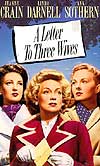 Joseph
L. Mankiewicz wrote and/or directed a number of acidic comedy/dramas in
the 1940s, such as the charming fantasy The Ghost and Mrs. Muir (1947)
with Rex Harrison as ghostly Captain Gregg in a haunted seaside cottage
who develops a relationship with a widow (Gene Tierney), and the amusingly-clever
but neglected A Letter to Three Wives (1949) with Linda Darnell,
Ann Sothern, and Jeanne Crain as recipients of a letter informing them
that one of their husbands has skipped town with another woman. At the
start of the next decade, he was responsible for the acclaimed, biting
backstage drama All About Eve (1950). One
of the most memorable romances and tearjerkers of the decade, Now,
Voyager (1942), featured Bette Davis as a transformed ugly duckling
spinster who was offered a lit cigarette [a metaphor for sex] by a suave
Paul Henreid. Joseph
L. Mankiewicz wrote and/or directed a number of acidic comedy/dramas in
the 1940s, such as the charming fantasy The Ghost and Mrs. Muir (1947)
with Rex Harrison as ghostly Captain Gregg in a haunted seaside cottage
who develops a relationship with a widow (Gene Tierney), and the amusingly-clever
but neglected A Letter to Three Wives (1949) with Linda Darnell,
Ann Sothern, and Jeanne Crain as recipients of a letter informing them
that one of their husbands has skipped town with another woman. At the
start of the next decade, he was responsible for the acclaimed, biting
backstage drama All About Eve (1950). One
of the most memorable romances and tearjerkers of the decade, Now,
Voyager (1942), featured Bette Davis as a transformed ugly duckling
spinster who was offered a lit cigarette [a metaphor for sex] by a suave
Paul Henreid.
Frank Capra's "Capra-Corn" Films:
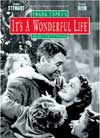 Frank
Capra, who had won three Best Director Academy Awards in the 30s (1934,
1936, and 1938), idealized the "common man" in his first independent production
titled Meet John Doe (1941) starring Gary
Cooper and Barbara Stanwyck. His most "Capra-esque" film was his irresistible,
sentimental, perennially-favorite Christmas holiday film, It's
A Wonderful Life (1946) - but this sleeper film was surprisingly
a major flop at the time of its original release. It only became popularized
after repeated Christmas-time TV viewings. James Stewart (as George Bailey)
contemplated suicide but after viewing the evil vision of Pottersville
(and being aided by angel Clarence) decided to be reunited with his family
in the sentimental ending. Frank
Capra, who had won three Best Director Academy Awards in the 30s (1934,
1936, and 1938), idealized the "common man" in his first independent production
titled Meet John Doe (1941) starring Gary
Cooper and Barbara Stanwyck. His most "Capra-esque" film was his irresistible,
sentimental, perennially-favorite Christmas holiday film, It's
A Wonderful Life (1946) - but this sleeper film was surprisingly
a major flop at the time of its original release. It only became popularized
after repeated Christmas-time TV viewings. James Stewart (as George Bailey)
contemplated suicide but after viewing the evil vision of Pottersville
(and being aided by angel Clarence) decided to be reunited with his family
in the sentimental ending.
Three Controversial Films:
The steamy box-office success of
Forever Amber (1947), a colorful costume romance-drama with brunette
star Linda Darnell as a bleached blonde 17th century English beauty (Amber
St. Clair), was severely 'condemned' by the Legion of Decency for glorifying
"immorality and licentiousness." And director Victor Fleming's final film
- the Technicolored Joan of Arc (1948), noted as the most expensive
film of the 40s decade at $8.7 million and also a major flop, was also
controversial because its lead star (32 year-old Ingrid Bergman) - playing
a teenaged peasant girl/saint - was revealed to be having an affair with
Italian director Roberto Rossellini. She was blacklisted and driven from
Hollywood to live abroad - until making her return to the screen in the
mid-50s with Anastasia (1956).
Producer/promoter Kroger Babb's (self-dubbed as "America's
Fearless Young Showman") low-budget, heavily-promoted Mom and
Dad (1944) was one of the most successful exploitation films of all
time. Besides being socially-significant as a sex-hygiene film about the
dangers of venereal disease and the results of premarital sex, it was
the 3rd highest grossing film during the 1940s, and easily recouped its
$62,000 in expenses. About 300 prints of this feature drama were made
and road-showed for more than two decades, with screenings divided by gender. Each print (with a tacked-on
live-birth sequence) traveled with a lecturer named Elliot Forbes --
an "eminent sexual hygiene commentator" -- (and two assisting
nurses) who promoted the film's "educational" value, lectured during intermission about the importance of contraception ("sensible sex"), and profitably
sold sex manuals in the theaters. Time Magazine remarked that the
ad campaign for Mom and Dad "left only the livestock unaware
of the chance to learn the facts of life."
 Film History of the 1940s
Film History of the 1940s
Part 1, Part 2, Part 3, Part 4, Part 5, Part 6

 
|
